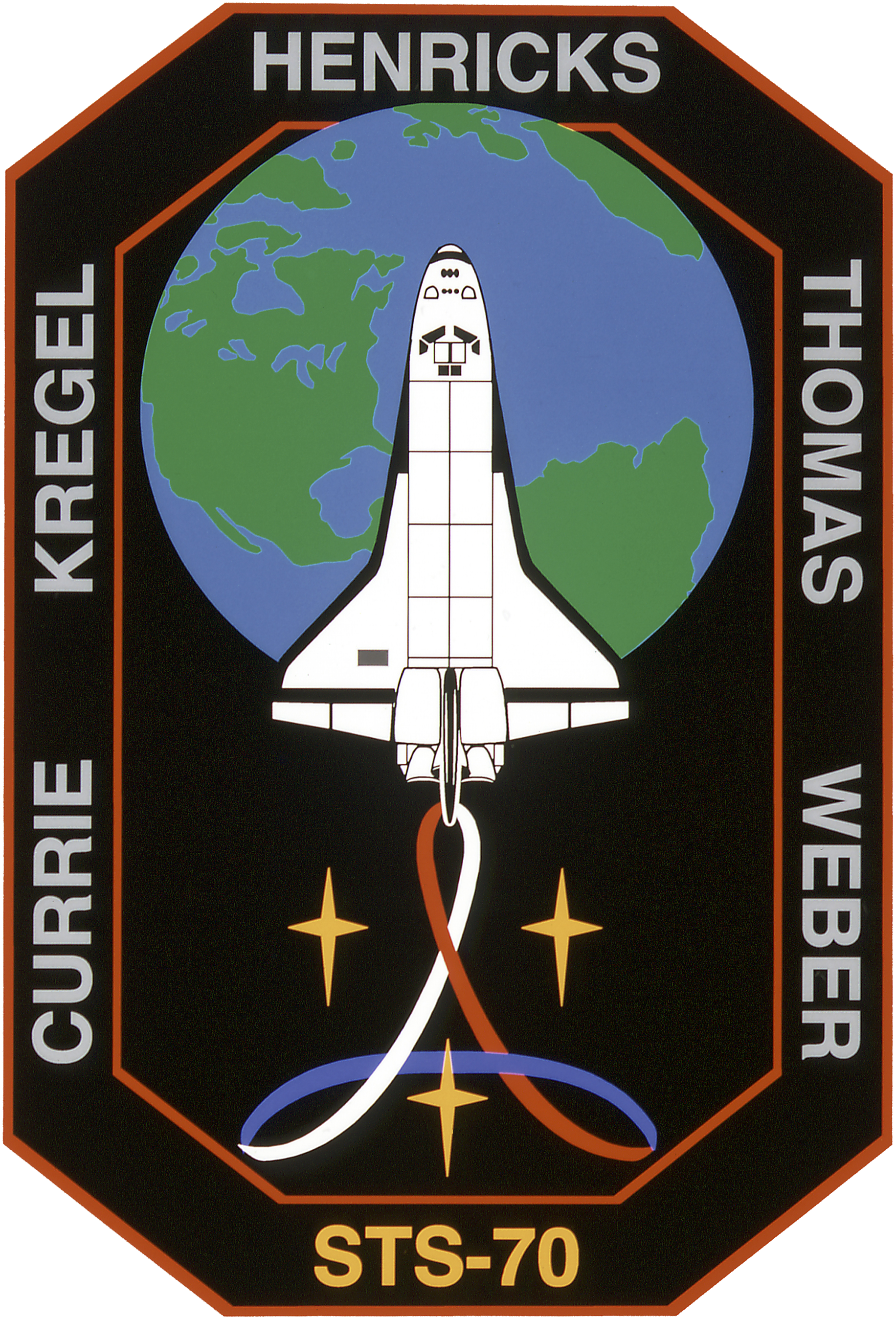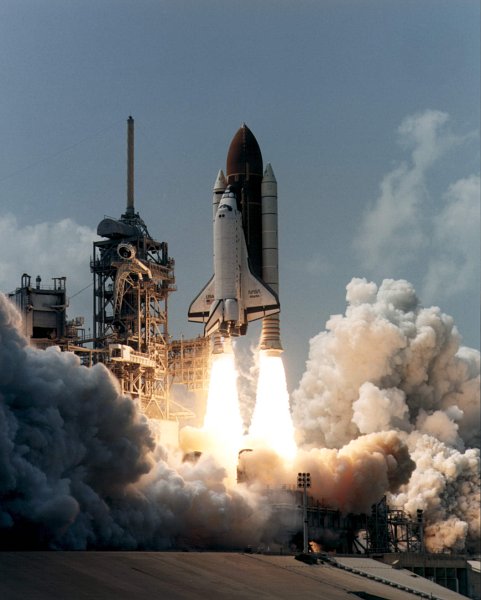|
STS-70
STS-70 was the 21st flight of the Space Shuttle Space Shuttle Discovery, ''Discovery'', and the last of 7 shuttle missions to carry a Tracking and Data Relay Satellite (TDRS). This was the first shuttle mission controlled from the new mission control center room at the Johnson Space Center in Houston. STS-70 was also the first flight of the new Block 1 orbiter main engine, designed to improve both engine performance and safety. The mission was launched from Kennedy Space Center in Florida on July 13, 1995, only six days after the landing of sister ship ''Atlantis'', marking the fastest turnaround between flights in the history of the program. Crew Crew seat assignments Preparations and launch STS-70 had originally moved ahead of STS-71 because of a delay in the launch of the Russian Spektr laboratory module to the Russian space station Mir. However, on May 31, 1995, shuttle managers assessed damage to the External Tank of STS-70 caused by nesting northern flicker, flicker ... [...More Info...] [...Related Items...] OR: [Wikipedia] [Google] [Baidu] |
Mary Ellen Weber
Mary Ellen Weber (born August 24, 1962) is an American executive, scientist, aviator, and a former NASA astronaut. Education Weber was born in Cleveland, Ohio, and raised in Bedford Heights, Ohio. She graduated from Bedford High School (Ohio), Bedford High School in 1980; received a B.S. in 1984 in chemical engineering (with honors) from Purdue University, where she was a member of Phi Mu sorority; received a Ph.D. in physical chemistry from the University of California, Berkeley in 1988; and received an M.B.A. from Southern Methodist University in 2002. Pre-NASA career As an undergrad, Weber was a chemical engineering intern at Ohio Edison, Delco Electronics, and 3M. In her doctoral research at Berkeley, she explored the physics of chemical reactions involving silicon. At Texas Instruments she researched new processes and revolutionary equipment for making computer chips, with SEMATECH and Applied Materials. She holds one patent and published nine papers in scientific journ ... [...More Info...] [...Related Items...] OR: [Wikipedia] [Google] [Baidu] |
TDRS-7
TDRS-7, known before launch as TDRS-G, is an American communications satellite, of first generation, which is operated by NASA as part of the Tracking and Data Relay Satellite System. It was constructed by TRW as a replacement for TDRS-B, which had been lost in the ''Challenger'' accident, and was the last first generation TDRS satellite to be launched. History TDRS-7 is based on a custom satellite bus which was used for all seven first generation TDRS satellites. Whilst similar to its predecessors, it differed from them slightly in that twelve G/H band (C band (IEEE)) transponders which had been included on the previous satellites were omitted. It was the last communications satellite, other than amateur radio spacecraft, to be deployed by a Space Shuttle. Launch The TDRS-G satellite was deployed from during the STS-70 mission in 1995. ''Discovery'' was launched from Kennedy Space Center Launch Complex 39B at 13:41:55 UTC on 13 July 1995. TDRS-G was deployed from ''Disco ... [...More Info...] [...Related Items...] OR: [Wikipedia] [Google] [Baidu] |
STS-69
STS-69 was a Space Shuttle ''Endeavour'' mission, and the second flight of the Wake Shield Facility (WSF). The mission launched from Kennedy Space Center, Florida on 7 September 1995. It was the 100th successful crewed NASA spaceflight, not including X-15 flights. Crew Spacewalks ;EVA 1 – Voss and Gernhardt *EVA 1 Start: 16 September 1995 – 08:20 UTC *EVA 1 End: 16 September 1995 – 15:06 UTC *Duration: 6 hours, 46 minutes Crew seat assignments Mission highlights The 11-day mission was the second flight of the Wake Shield Facility (WSF), a saucer-shaped satellite that was to fly free of the Shuttle for several days. The purpose of the WSF was to grow thin films in a near perfect vacuum created by the wake of the satellite as it moved through space. The crew also deployed and retrieved the Spartan 201 astronomy satellite, performed a six-hour spacewalk to test assembly techniques for the international Space Station and tested thermal improvements made to spacesuit ... [...More Info...] [...Related Items...] OR: [Wikipedia] [Google] [Baidu] |
STS-71
As the third mission of the US/Russian Shuttle-Mir Program, STS-71 became the first Space Shuttle to dock with the Russian space station ''Mir''. STS-71 began on June 27, 1995, with the launch of Space Shuttle ''Atlantis'' from launchpad 39A at the Kennedy Space Center in Florida. The Shuttle delivered a relief crew of two cosmonauts Anatoly Solovyev and Nikolai Budarin to the station and recovered Increment astronaut Norman Thagard. ''Atlantis'' returned to Earth on July 7 with a crew of eight. It was the first of seven straight missions to ''Mir'' flown by ''Atlantis'', and the second Shuttle mission to land with an eight-person crew after STS-61-A in 1985. For the five days the Shuttle was docked to ''Mir'' they were the largest spacecraft in orbit at the time. STS-71 marked the first docking of a Space Shuttle to a space station, the first time a Shuttle crew switched members with the crew of a station, and the 100th crewed space launch by the United States. The mission ... [...More Info...] [...Related Items...] OR: [Wikipedia] [Google] [Baidu] |
Kennedy Space Center Launch Complex 39B
Launch Complex 39B (LC-39B) is the second of Launch Complex 39's three launch pads, located at NASA's Kennedy Space Center in Merritt Island, Florida. The pad, along with Launch Complex 39A, was first designed for the Saturn V launch vehicle, which at the time was the United States' most powerful rocket. Typically used to launch NASA's crewed spaceflight missions since the late 1960s, the pad is currently configured for use by the agency's Space Launch System rocket, a Shuttle-derived launch vehicle which is currently used in the Artemis program and subsequent Moon to Mars campaigns. The pad had also been leased by NASA to aerospace company Northrop Grumman, for use as a launch site for their Shuttle-derived OmegA launch vehicle, for National Security Space Launch flights and commercial launches, before the OmegA program was cancelled. History Apollo program In 1961, President Kennedy proposed to Congress the goal of landing a man on the Moon by the end of the decade. Congre ... [...More Info...] [...Related Items...] OR: [Wikipedia] [Google] [Baidu] |
Inertial Upper Stage
The Inertial Upper Stage (IUS), originally designated the Interim Upper Stage, was a Multistage rocket, two-stage, Solid-propellant rocket, solid-fueled space launch system developed by Boeing for the United States Air Force beginning in 1976 for raising payloads from low Earth orbit to higher orbits or interplanetary trajectories following launch aboard a Titan 34D or Titan IV rocket as its upper stage, or from the payload bay of the Space Shuttle as a space tug. Development During the development of the Space Shuttle, NASA, with support from the Air Force, wanted an upper stage that could be used on the Shuttle to deliver payloads from low earth orbit to higher energy orbits such as geostationary transfer orbit, GTO or geostationary orbit, GEO or to escape velocity for planetary probes. The candidates were the Centaur (rocket), Centaur, propelled by liquid hydrogen and liquid oxygen, the Transtage, propelled by hypergolic storable propellants Aerozine-50 and dinitrogen tetroxide ... [...More Info...] [...Related Items...] OR: [Wikipedia] [Google] [Baidu] |
Space Shuttle Discovery
Space Shuttle ''Discovery'' (Orbiter Vehicle Designation: OV-103) is a retired American Space Shuttle orbiter. The spaceplane was one of the Space Shuttle orbiter, orbiters from NASA's Space Shuttle program and the third of five fully operational orbiters to be built. Its first mission, STS-41-D, flew from August 30 to September 5, 1984. Over 27 years of service it launched and landed 39 times, aggregating more spaceflights than any other spacecraft . The Space Shuttle launch vehicle had three main components: the Space Shuttle orbiter, a single-use central fuel tank, and two reusable solid rocket boosters. Nearly 25,000 Space Shuttle thermal protection system, heat-resistant tiles cover the orbiter to protect it from high temperatures on re-entry. ''Discovery'' became the third operational orbiter to enter service, preceded by ''Space Shuttle Columbia, Columbia'' and ''Space Shuttle Challenger, Challenger''. After the Challenger and Columbia accidents, Discovery became the ... [...More Info...] [...Related Items...] OR: [Wikipedia] [Google] [Baidu] |
Mission Control Center
A mission control center (MCC, sometimes called a flight control center or operations center) is a facility that manages spaceflight, space flights, usually from the point of launch until landing or the end of the mission. It is part of the ground segment of spacecraft operations. A staff of flight controllers and other support personnel monitor all aspects of the mission using telemetry, and send commands to the vehicle using ground stations. Personnel supporting the mission from an MCC can include representatives of the attitude control system, electric power, power, spacecraft propulsion, propulsion, thermal, attitude dynamics and control, attitude dynamics, orbital operations and other subsystem disciplines. The training for these missions usually falls under the responsibility of the flight controllers, typically including extensive rehearsals in the MCC. Government-operated Mission Control Centers ;America * Launch Control Center, NASA Launch Control Center controls NASA ... [...More Info...] [...Related Items...] OR: [Wikipedia] [Google] [Baidu] |
Johnson Space Center
The Lyndon B. Johnson Space Center (JSC) is NASA's center for human spaceflight in Houston, Texas (originally named the Manned Spacecraft Center), where human spaceflight training, research, and flight controller, flight control are conducted. It was renamed in honor of the late U.S. president and Texas native, Lyndon B. Johnson, by an act of the United States Senate on February 19, 1973. JSC consists of a complex of 100 buildings constructed on in Clear Lake (region), Clear Lake. The center is home to NASA Astronaut Corps, NASA's astronaut corps, and is responsible for training astronauts from both the U.S. and its international partners. It also houses the Christopher C. Kraft Jr. Mission Control Center, which has provided the flight controller, flight control function for every NASA human spaceflight since Gemini 4 (including Apollo program, Apollo, Skylab, Apollo–Soyuz, and Space Shuttle program, Space Shuttle). It is popularly known by its radio call signs "Mission Contr ... [...More Info...] [...Related Items...] OR: [Wikipedia] [Google] [Baidu] |
Space Shuttle Seating Plan
Space is a three-dimensional continuum containing positions and directions. In classical physics, physical space is often conceived in three linear dimensions. Modern physicists usually consider it, with time, to be part of a boundless four-dimensional continuum known as ''spacetime''. The concept of space is considered to be of fundamental importance to an understanding of the physical universe. However, disagreement continues between philosophers over whether it is itself an entity, a relationship between entities, or part of a conceptual framework. In the 19th and 20th centuries mathematicians began to examine geometries that are non-Euclidean, in which space is conceived as '' curved'', rather than '' flat'', as in the Euclidean space. According to Albert Einstein's theory of general relativity, space around gravitational fields deviates from Euclidean space. Experimental tests of general relativity have confirmed that non-Euclidean geometries provide a better model f ... [...More Info...] [...Related Items...] OR: [Wikipedia] [Google] [Baidu] |
Northern Flicker
The northern flicker or common flicker (''Colaptes auratus'') is a medium-sized bird of the woodpecker family. It is native to most of North America, parts of Central America, Cuba, and the Cayman Islands, and is one of the few woodpecker species that Bird migration, migrate. Over 100 common names for the northern flicker are known, including yellowhammer (not to be confused with the Yellowhammer, Eurasian yellowhammer (''Emberiza citrinella'')), clape, gaffer woodpecker, harry-wicket, heigh-ho, wake-up, walk-up, wick-up, yarrup, and gawker bird. Many of these names derive from attempts to imitate some of its Bird vocalization, calls. It is the state bird of Alabama (known by its colloquial name "yellowhammer"). Taxonomy The English naturalist Mark Catesby described and illustrated the northern flicker in his book ''The Natural History of Carolina, Florida and the Bahama Islands'' which was published between 1729 and 1732. Catesby used the English name "Gold-winged Wood-pecker" ... [...More Info...] [...Related Items...] OR: [Wikipedia] [Google] [Baidu] |







